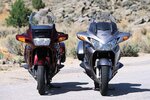From the NH Forum, more detail. There were a couple of comments or questions which I omitted, which is why some of my comments appear to be responses:
And from another thread, which became more of a discussion:
Let me see if I can explain better: We agree that the chain, sprockets, and even bearings will suffer extreme wear and possible damage with the chain too tight. The following presumes that we have lubed the chain and found the tightest point in its rotation:
A chain connecting two fixed-in-place sprockets can be tightened well without damage, because the distance between them doesn't change during operation. The chain on a bike must cope with varying distances, because the swing-arm pivot is closer to the rear axle.
As the rear suspension moves, the rear sprocket moves in an arc. The two sprockets are the farthest apart when the two sprockets and the swing-arm pivot are in a straight line. No matter what movement happens, the sprockets will never be farther apart than that.
The 3/4" of slack spec is with the bike on the side stand, when the swing-arm pivot is nowhere near being in a straight line with the sprockets, which makes it an approximation at best. What happens on a bike with worn or different-than-stock length springs?
What I do is pull them into that straight line with a ratchet strap. I take the seat off, run the strap over the frame, under swing-arm on both sides, back over frame and hook the ends together. Then I tighten the strap until the straight line has been achieved.
Now, no matter how the suspension moves in operation, whether from load weight or aggressive riding, the chain will never be pulled tighter than it is at this point. If I adjust for minimal slack now, the tightest the chain will ever be in use is how tight I make it now.
If your point is, even knowing what I'm saying above is physically correct, that my 1/4" of slack is too little for a chain with fixed-distance sprockets, then that is a separate debate. I will do some research and report back with my findings. Until then . . .
Purposely avoiding motorcycle and bicycle sites, here's the first thing I found:
https://www.cisco-eagle.com/service...maintenance/conveyor-maintenance/belt-tension
And yes, as the chain wears, the pin-to-pin distance increases, which allows the rollers to ride higher on the sprocket teeth, which in turn increases chain wear, and the effect snowballs. That's why old sprockets cause new chains to wear faster.
I didn't read about doing this anywhere; it just came to me while thinking about it. I believe the tighter the chain, without being tight enough to increase friction or squeeze out the lubricant, the better. There's no advantage to the loose side flopping around.
An extremely-too-tight chain could even stop the suspension from compressing. Here's just about everything you could ever want to know about chains. There's even a motorcycle chain section in the index:
http://tsubaki.ca/pdf/library/the_Complete_guide_to_chain.pdf
On my '96, as well as my old '82, the suspension must be compressed for that alignment. It's strange to me yours doesn't. I'll have to look for pics of Nighthawks without mufflers.
Various thoughts:
1. Perhaps you have shorter-than-stock shock/spring units, but I can't imagine all of the suspension travel is only above the straight line. That would be such a waste of available travel.
2. I would expect to find the straightest alignment with the bike nominally loaded and with the suspension correctly adjusted for that amount of load, not at either end of range of motion.
3. A center-to-center change of 1/4" would, of course, result in a change of much, much more than 1/4" of chain slack. A quarter turn of the adjuster bolts can go from too loose to too tight.
4. I've had a 16-tooth sprocket on hand for some time, waiting for either the existing Regina chain to wear enough to fit, or wear enough to be replaced with the waiting 112-link chain.
HP is saying that, if you start with the three points in a straight line, that slack can only increase. We all agree on that. What's different is that he believes that those points are in line with the swing-arm at it's lowest position, i.e., with the bike on the center stand.
You and I obviously agree that the straight line occurs only with weight on the bike, which is what I mimic when ratcheting the swing-arm upward. I also do this with the bike on the center stand, otherwise the bike could fall to the right, pushed by the kick stand.
I think designing a bike with the swing-arm straight with no weight on it would be to intentionally waste 50% of the available suspension travel. As I said in a previous post, I think the straight line only occurs when the bike is well loaded, like with a passenger.
If the sprockets are at maximum distance apart, and the chain at the tightest place, the chain will never be tighter. So, what's "too tight" about 1/4" of play?
Only because, as rarely as a chain adjustment is needed, I would have to make sure that the bike is sitting exactly the same every time.
Plus, how do you make sure the chain is at the tightest place with the rear wheel on the ground?
I have seen such a setup accomplished in two different ways:
1. A custom frame was made with the swing-arm pivot points outboard of, and in line with the counter-shaft (front sprocket).
2. A dual sprocket was mounted on the swing-arm pivot shaft, and there were separate front and rear chains. This was made to allow for an extra-wide rear wheel.
To add, yes, the chain slackens a bit with the suspension either compressed or extended from the center, straight-line position.
The question is: by how much, exactly? How do we know that every '91-'03 NH750 is sitting with the rear compressed the same amount every time it's parked?
I believe the side-stand recommendation is based at least partly on the fact that the center stand was not standard equipment.
And, there is the previously-mentioned variations in wear along the length of used chains, which either must be found or allowed for.
I believe the goal is to have as little slack as possible without ever getting tighter. What works better to obtain than my method?
I merely meant that no one number applies to every bike, so the recommended slack is an average-based compromise, and my method applies to my chain on my sprockets on my bike. I'm concerned only with my bike, as I'm not responsible for writing a user's manual for everyone else's bike.
As long as that too-tight point is avoided, the best mechanical efficiency in transferring energy is achieved with a snug chain. I do spin he rear wheel around a few times in both directions and check for a missed tight spot after adusting.
To me, my method firstly avoids the possibility of making the chain tight enough to risk any of the above caveats, and secondly, otherwise allows me to get it as snug as practicable while avoiding "firstly."
http://chain-guide.com/basics/7-1-2-1-chain-slack.html
http://chain-guide.com/basics/2-1-2-engagement-with-sprockets.html
Additional food for thought:
I imagine that a bike's suspension (or any vehicle, really) would be designed so that, during normal load and usage, there is much more compression travel available than extension travel.
I have new Hagon shocks with springs selected by Dave Quinn (ret.) after discussing my weight, the full luggage system I added, tools and such I normally carry, and allowance for a passenger.
Combining the two lends me to believe I'll never ride an appreciable distance (if any) with the suspension compressed to the point of minimum chain slack.
The way I do it, there are no measurements and, right or wrong, the chain ends up being as snug as it can be while still assuring no chance of binding.



